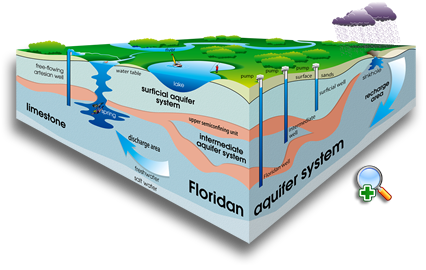Value of water
Florida is surrounded on three sides by water, and has thousands of lakes, wetlands, and many streams and rivers. With all of this water, many people may not realize the need to conserve or the need to plan for how to meet future water supply needs. Although it may appear that Florida has plentiful water, not all of that water is fresh and readily available for drinking or other uses.

Water plays a vital role in our quality of life, recreation, agriculture and economy. Having enough water to meet our needs while protecting the environment is very important.
Where does our water come from?
The Upper Floridan aquifer historically is the principal source of freshwater in central Florida.

An aquifer core sample. Water moves through the holes and cracks of limestone formations that are part of the aquifer system.
The Floridan aquifer system (FAS) is mainly composed of limestone and dolomite. Limestone acts as a sponge, absorbing and holding water. The texture, however, doesn’t feel like a sponge at all. It is very hard and full of voids and crevices that allow water to move freely through it.
The FAS lies below a confining layer of clay that protects the water from contamination. Throughout most of central Florida, the quality of water in the FAS is excellent.
How is our water replenished?
The FAS is replenished in a natural process called recharge. Recharge occurs when water seeps from the land’s surface down through the layers of earth into an aquifer, such as after it rains.
Discharge occurs when water pressure in the FAS is greater than land elevations, and water rises to form
springs and free-flowing artesian wells. However, most water is discharged when wells are drilled to pump out
water from the aquifer.
While Florida generally receives 50 to 55 inches of rainfall each year, not all of the rain reaches the aquifer. About 37 inches evaporates or runs off the land into surface waters before it has a chance to soak into the ground. That leaves potentially about 13 inches annually available to recharge the aquifer in limited areas.
What happens if we use too much groundwater?

Pumping too much groundwater from the aquifer changes the pressure, drawing water down from the land surface and drawing saltwater up into freshwater zones.
This can result in unacceptable impacts, such as drying out wetlands, reducing spring flows, lowering lake levels and degrading groundwater quality from saltwater intrusion.
Water managers are responsible for ensuring there is enough water available for people, homes, businesses, agriculture and other users, while at the same time ensuring enough water is available for plants and animals.
That's why water supply planning is so important. Water supply planning efforts help us identify the projected population and how much water we will need in the next 20 years as well as potential sources of water and funding to meet those future demands.